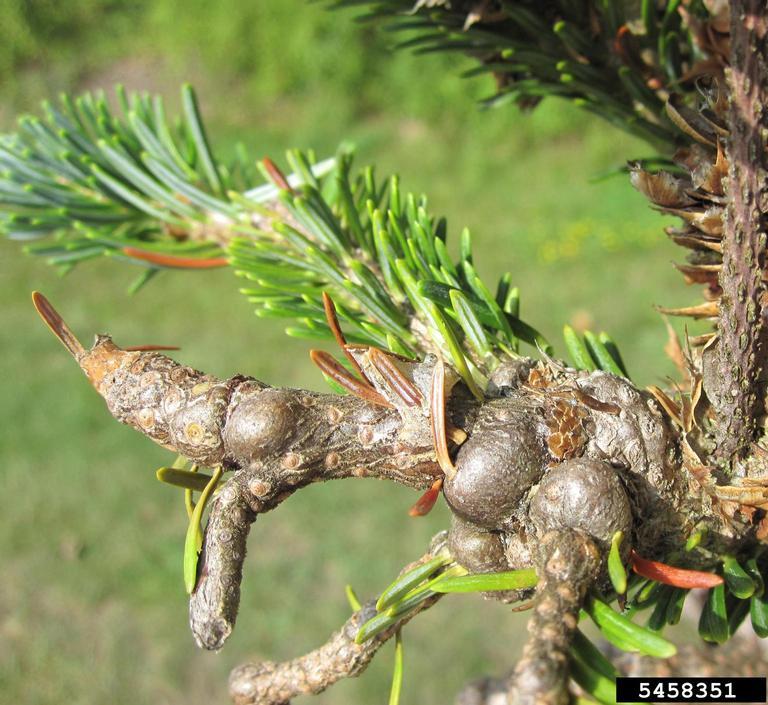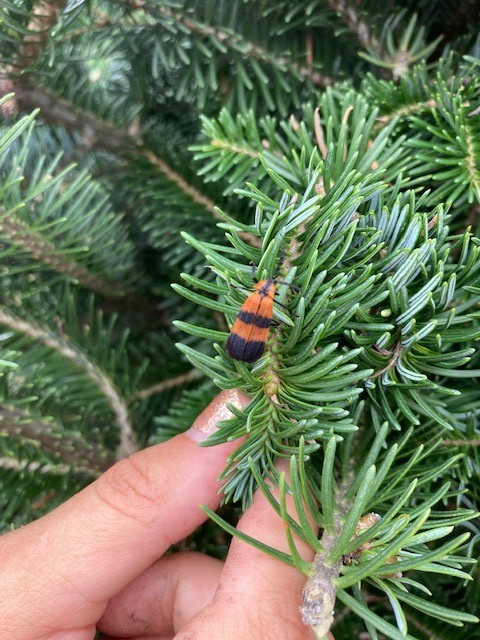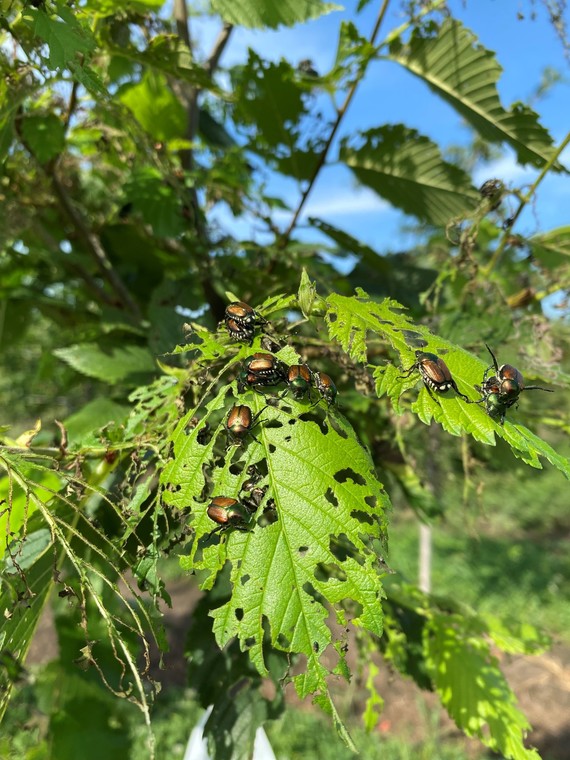 Dear Wisconsin nursery growers, Christmas tree growers, and gardeners,
We hope you have been enjoying the sunny weather and the prelude to autumn in Wisconsin. We are pleased to let you know that the U.S. Fish and Wildlife Service recently released the final recovery plan for the endangered rusty-patched bumblebee, one of the native species we are striving to support by encouraging people to implement BMPs outlined in Wisconsin's Pollinator Protection Plan. We also really enjoyed seeing many of you at the Wisconsin Christmas Tree Producers Association meeting in Merrill recently. Below are some field updates, including many items of interest to Christmas tree growers. Please send any feedback, questions, or ideas you have for future e-news updates to datcpnursery@wisconsin.gov.
Having trouble viewing this email? View it as a Web page.
Important Christmas Tree Program and Regulatory Changes
As we approach Christmas tree field inspection season, we want to make sure all of our growers are aware of some recent changes to plant regulations and changes (hopefully improvements) to the way we are doing field inspections that might impact you.
First, the common name gypsy moth will be changed to a yet to be determined name as part of a Better Common Names initiative that the Entomological Society of America has undertaken in order to update potentially offensive or non-inclusive common names for various insects. For now, we will likely be using the scientific name for this regulatory pest, which is Lymantria dispar.
Growers should also be aware that Eau Claire and Richland counties were added to the Lymantria dispar quarantine in May 2021. Growers in these counties shipping out of state will be contacted by the U.S. Department of Agriculture (USDA) to go over a compliance agreement in order to ship stock.
Another change is that the pine shoot beetle (PSB) was deregulated by USDA in November 2020, based on the lack of observed severe impacts by this pest in the 20 states where it has been introduced. This means that growers will not be required to sign a compliance agreement for PSB, which is hopefully welcome news.
If you plan to ship Christmas trees out of state, be aware of other states’ external quarantines and other regulations for all plants, pests, and diseases. The best way to do this is to check the regulatory summaries posted on the National Plant Board website, as these are updated periodically.
Finally, Christmas tree growers should be aware that inspection reports will now be completed electronically and emailed to growers with an email address on file once or twice a week. If no email address was provided, paperwork will be printed and mailed. Contact Ian Gallo, DATCP Regulatory Specialist at ian.gallo@wisconsin.gov to add an email address for receiving these inspection reports.
Thank you for your patience and understanding as we acclimate ourselves to this new system. We are hoping that it will actually get you more timely inspection data now and in the future.
 Image of Northern Unit Supervisor, Jen Oestreich, inspecting a Christmas tree field for pests and diseases
Balsam Woolly Adelgid Detection in Michigan Shows Value of Early Detection, Rapid Response to Invasive Forest Pests
In mid-August, the Wisconsin Department of Agriculture, Trade and Consumer Protection (DATCP) was dismayed to hear that Michigan Department of Agriculture and Rural Development (MDARD) had the state’s first verified detection of balsam woolly adelgid (BWA). The state is still working to identify the source of the introduction and delimiting the extent of the infestation, but it is possible that it came in on infested nursery stock.
BWA is a tiny, sap-feeding insect native to Europe that attacks true firs, including balsam, Fraser and Concolor (white) fir. Repeated attacks from BWA weakens trees, causes twig gouting, kills branches and results in tree mortality. Symptoms of BWA infestation include: Tiny 1- to 2-millimeter, white woolly tufts on the lower bole and larger branches in spring and summer; Swelling and distortion of the twigs, commonly called gout; branches that turn brick-red and die; and misshapen tree crowns with few needles.
In 2014, MDARD implemented a BWA quarantine regulating the movement of potentially infested nursery stock from areas in North America on the east and west coast with known infestations. Similar regulations are being considered in Wisconsin due to threats BWA poses to our Christmas tree industry and native balsam fir forests.
The silver lining in this situation is that the pest was first reported by an arborist on private land in Kent County. This underlies the importance of enlisting the public and tree care industry staff in the early detection of forest pests, as that often allows for a more economical, effective rapid response. This also means that it is crucial to be on the lookout for this pest and report it to the pest hotline at 866-440-7523 or datcppesthotline@wisconsin.gov.
 Image of Balsam Woolly Adelgid branch gouting, Dawn Dailey O'Brien, Cornell University, Bugwood.org
Large Numbers of Beneficial Net-Winged Beetles in Conifer Fields
During a recent Christmas tree field inspection in Marinette County, a high number boldly colored orange and black beetles were observed resting on the needles of several trees in a field of Canaan fir. A sample was collected and the insects were identified as End Banded Net Wing Beetles (Calopteron terminale). This is a native insect which inhabits deciduous forests. Eggs are deposited on dead or dying forest trees. When the larvae hatch they feed on arthropods under the bark. The adults may be seen between July and September. Adults are slow flyers and feed on nectar. This beetle plays a beneficial role in its habitat. It is not an agricultural pest or a pest of Christmas trees, so there is no need to worry if you notice these in your fields this time of year.
 Net winged Beetles in Wisconsin Christmas tree field
Weir's Cushion Rust Detected on Colorado Blue Spruce in Wisconsin
Growers of Colorado Blue Spruce should check their fields for yellow spots forming on this year’s current needles, now in August through the month of October.
Weir’s Cushion Rust will infect Colorado Blue Spruce trees that are growing too crowded in a nursery field, especially those growing in an area with reduced air circulation around the tree’s branches. The first sign of infection is yellow spots on this year’s needles, as shown in the photo. Next spring in May, the rust spores will emerge from those spotted needles and blow to nearby Spruce trees infecting new needles all over again. This rust is autoecious and does not have to blow back to an alternate host plant. It can spread quickly through a spruce field, greatly reducing the aesthetic value. Infected needles will turn off color and drop off the tree, leaving scraggly-looking shoot tips.
This rust fungal disease will not go away on its’ own and will continue to infect new needles every year, unless you start a control treatment program going forward, for a minimum of two years. If crowded air circulation conditions are not improved, moisture-holding needles will be infected. Treatments will have limited success unless fungicide control sprays penetrate the branches and cover new needle surfaces throughout the tree. If you miss an area they will continue to infect nearby spruce needles.
Weir’s Cushion Rust yellow spots were detected at a Polk County nursery grower's field this year, and inspectors may also find it at other locations during Christmas tree inspections this fall.
 Image of Weir's Cushion Rust, Konnie Jerabek
Japanese Beetles Observed Throughout Wisconsin in August
As nursery inspectors wrap up nursery inspections around the state, we are still seeing Japanese beetles actively feeding on trees, shrubs, crops and other plants.
The Japanese beetle is a highly destructive plant pest that is difficult to control. Japanese beetle adults typically begin to emerge in Wisconsin in late-June or early-July and attack the foliage, flowers, or fruits of more than 350 different ornamental and agricultural plants through September. They overwinter underground as grubs and feed on grass roots, damaging lawns, golf courses, and pastures. Japanese beetles were first found in the U.S. in 1916 in New Jersey. Since then Japanese beetles have spread throughout most states east of the Mississippi River. Partial infestations also occur west of the Mississippi River.
To help slow the spread of Japanese beetle movement on nursery stock, the National Plant Board, along with state and federal partners developed the U.S. Domestic Japanese Beetle Harmonization Plan. If you are a Wisconsin nursery shipping nursery stock (with the exception of bare root stock) west of Minnesota, you likely need a Japanese Beetle Compliance Agreement with us. Because states west of us are not generally infested with Japanese beetle, they require nursery stock to be free of all Japanese beetle life stages. In order to protect those uninfested states, or partially infested, from receiving plant material containing Japanese beetle, Wisconsin producers and distributors of plants are responsible for understanding and complying with the Japanese beetle certification requirements of destination states.
Visit DATCP's Japanese Beetle page to learn more about the Japanese Beetle Harmonization Plan for Wisconsin Nursery growers. Visit UW-Extension for more information about managing Japanese beetles in Wisconsin.
 Japanese Beetles on Princeton Elm, Liz Meils
Learn More
For more information about Wisconsin's Nursery Program, visit DATCP's Nursery and Christmas Tree Program webpage.
Division of Agricultural Resource Management | Bureau of Plant Industry
Having trouble viewing this email? View it as a Web page.
|